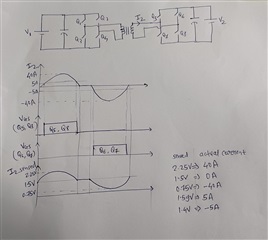Other Parts Discussed in Thread: TLV9032, TLV3601, TLV3201, TLV3501, TLV4376
Dear TI team,
I am using comparator IC LM2901PWR for 5A and -5A resonant current detection of bidirectional CLLLC converter. Resonant current will vary from +40A peak to -40A peak and I need to detect +5A and -5A. Maximum frequency of resonant current can be upto 200 kHz.
I have added offset to sensing signal so corresponding signal to controller will be 0 to 3V (1.5V corresponds to 0A and 1.59V corresponds to +5A and 1.4V will corresponds to -5A).
I will be using circuit similar to zero cross detection circuit with Input resistor divider network (application note SNOA999).
Kindly let me know if this device will be good choice of my application (regarding speed, noise, jitter).
Thanks,
Shritesh


